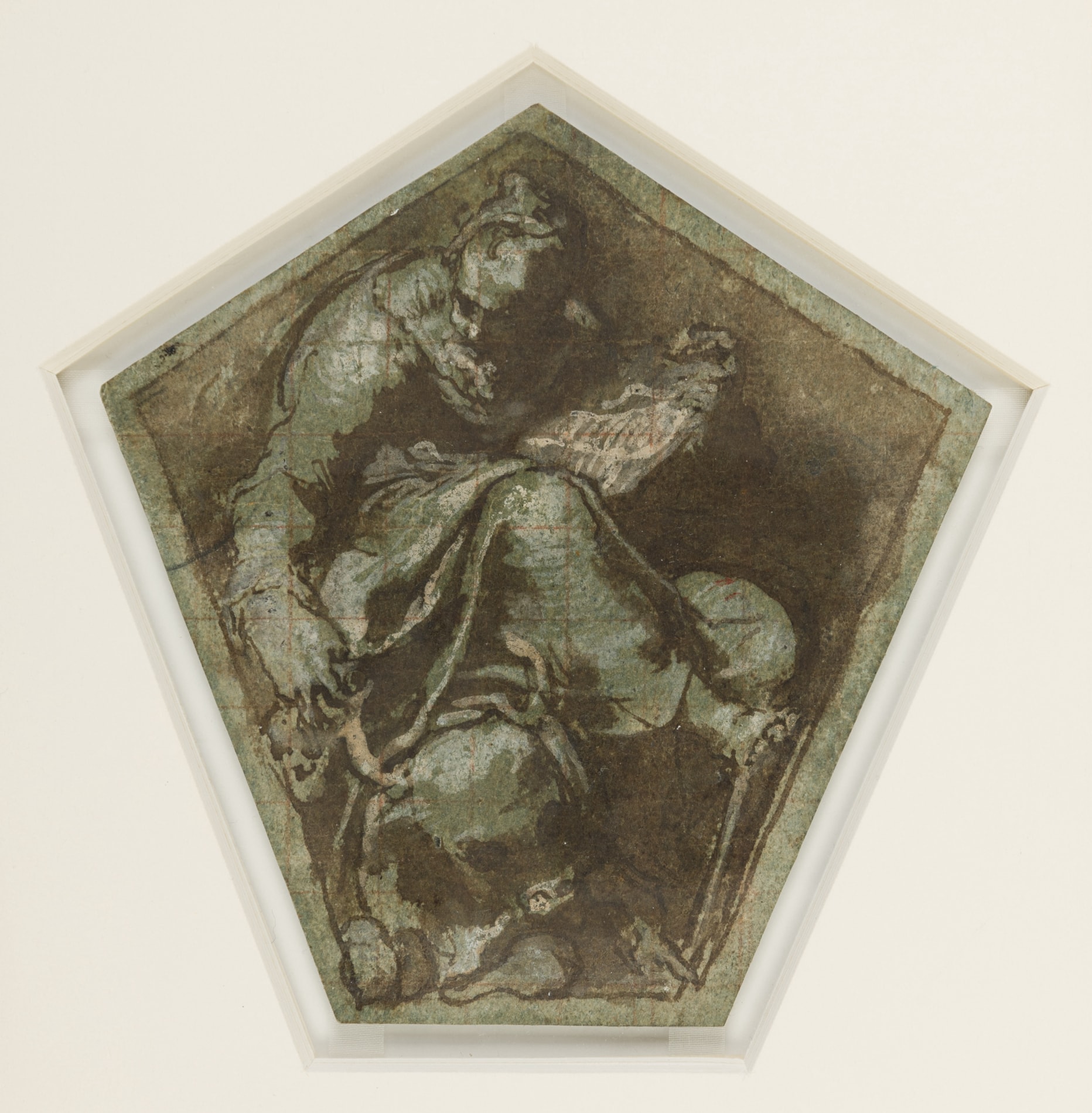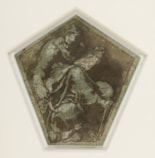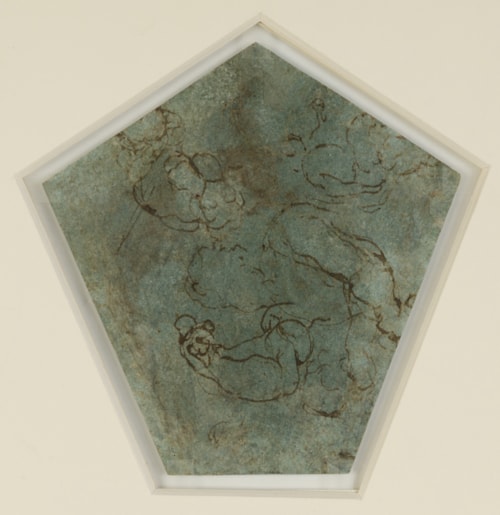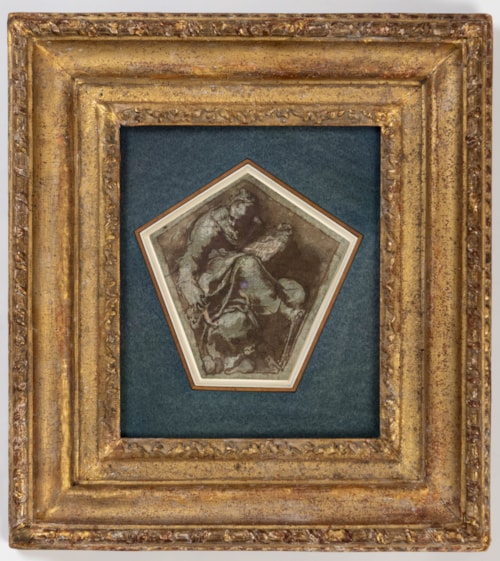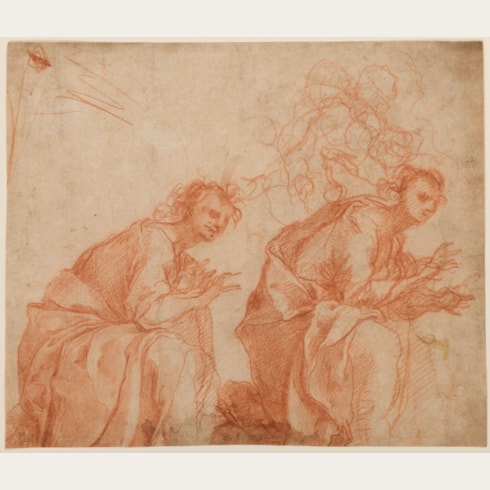Taddeo ZUCCARO
(Sant’Angelo in Vado 1529 - Rome 1566)
Design for a Pendentive with Saint Luke
Pen and brown ink and brown wash, with touches of white heightening, and squared in red chalk, within brown ink framing lines, on blue paper.
The verso with figure studies in brown ink.
147 x 142 mm. (5 3/4 x 5 5/8 in.) at greatest dimensions.
The verso with figure studies in brown ink.
147 x 142 mm. (5 3/4 x 5 5/8 in.) at greatest dimensions.
This is a study for what is arguably Taddeo Zuccaro’s most important surviving work, the fresco decoration of the Mattei Chapel in the church of Santa Maria della Consolazione in Rome, painted between 1553 and 1556. The decoration of the small chapel was the result of a commission from the nobleman Jacopo Mattei, who several years earlier had engaged the young Zuccaro to paint the façade of the Palazzo Mattei in Rome. As the 16th century painter and biographer Giorgio Vasari records, ‘M. Jacopo Mattei, having caused a chapel to be built in the Church of the Consolazione below the Campidoglio, allotted it to Taddeo to paint, knowing already how able he was; and he willingly undertook to do it, and for a small price, in order to show certain persons, who went about saying that he could do nothing save façades and other works in chiaroscuro, that he could also paint in colour. Having then set his hand to that work, Taddeo would only touch it when he was in the mood and vein to do well, spending the rest of his time on works that did not weigh upon him so much in the matter of honour; and so he executed it at his leisure in four years…The whole work, which was uncovered in the year 1556, when Taddeo was not more than twenty-six years of age, as held, as it still is, to be extraordinary, and he was judged by the craftsmen at that time to be an excellent painter.’ Zuccaro must have produced a large number of preparatory drawings for this important and extensive commission, but only a few are known today.
This drawing is an early preparatory study for one of the four Evangelists painted by Zuccaro on the pendentives of the vault of the Mattei Chapel, as noted by Vasari: ‘on the vaulting, about certain ornaments in stucco, are four half-length figures representing the Four Evangelists, which are very beautiful.’ The pendentives are very damaged today, and only three of them are still reasonably legible. Since the frescoed Evangelists are half-length figures, this squared drawing of a full-length seated figure of Saint Luke, as Gere has noted, ‘can reasonably be identified as a discarded design for one of the pendentives on the entrance-wall’ of the chapel. Another preparatory drawing for the same pendentive figure of Saint Luke, which also shows the figure full-length and is very similar in stylistic terms to the present sheet, is in the collection of the Archdiocesan Museum in Kroměříž in the Czech Republic.
Four other preparatory drawings by Taddeo Zuccaro related to the Evangelists in the Mattei Chapel are known. A drawing for the full-length pendentive figure of Saint John is in the Louvre, while a pen and wash study of a half-length figure of Saint Matthew with an Angel appears on the verso of a drawing in the Uffizi in Florence. What seems to be another early study for the Saint Matthew pendentive is in the collection of the Kunsthaus in Zurich. A sheet of red chalk figure studies of full-length Evangelists, on the verso of a drawing of a sibyl in a private collection, may also be related to the Mattei Chapel pendentives. As Julian Brooks has pointed out, based on the surviving drawings for the pendentives, ‘it is obvious that Taddeo initially wished to portray the evangelists full-length, although in the end he decided to show only their upper bodies and heads. Taddeo’s struggles to overcome the problem of showing the full body from below – while keeping the head visible and including an attribute… – are evident.’ Certainly, the visually striking pose of the Evangelist in the present sheet, like those of the saints in the related drawings in the Louvre and in Kroměříž, is quite different from the much more restrained half-length figures that were eventually frescoed in the chapel.
Among stylistically comparable drawings by Taddeo Zuccaro is a study of an angel seated on a cloud, likewise drawn in pen and brown ink and wash on blue paper, in the collection of the Raclin Murphy (formerly Snite) Museum at the University of Notre Dame in Indiana, and a drawing of Saint Paul Restoring Eutychus to Life in the same technique, in the Metropolitan Museum of Art in New York. Also similar in medium and technique is a drawing of Two Youths Asleep in a Landscapein the Kunsthaus in Zurich, which is a study for another fresco in the Mattei Chapel, as well as a Seated Sibyl in the Hamburger Kunsthalle in Hamburg and a drawing of a Roman soldier in the Biblioteca National in Rio de Janeiro, both of which can also be related to the same commission.
The studies of arms and torsos drawn in brown ink on the verso of the present sheet may likewise be tentatively related to the Mattei Chapel decorations, and in particular the vault fresco of The Arrest of Christ. When the sheet is turned 180 degrees, the study of a bent arm near the top edge of the verso can perhaps be regarded as a first idea for the arm of Saint Peter, holding a knife and attacking the fallen Roman soldier Malchus, near the centre of the painted composition. This figure also appears in Taddeo’s more elaborate compositional drawing for the fresco of The Arrest of Christ, in the Kupferstichkabinett in Berlin.
The first recorded owner of the present sheet was the Reverend John Sanford (1775-1855), who lived in Florence for much of the 1830s, and was among the foremost English collectors of Italian paintings in the first half of the 19th century.
This drawing is an early preparatory study for one of the four Evangelists painted by Zuccaro on the pendentives of the vault of the Mattei Chapel, as noted by Vasari: ‘on the vaulting, about certain ornaments in stucco, are four half-length figures representing the Four Evangelists, which are very beautiful.’ The pendentives are very damaged today, and only three of them are still reasonably legible. Since the frescoed Evangelists are half-length figures, this squared drawing of a full-length seated figure of Saint Luke, as Gere has noted, ‘can reasonably be identified as a discarded design for one of the pendentives on the entrance-wall’ of the chapel. Another preparatory drawing for the same pendentive figure of Saint Luke, which also shows the figure full-length and is very similar in stylistic terms to the present sheet, is in the collection of the Archdiocesan Museum in Kroměříž in the Czech Republic.
Four other preparatory drawings by Taddeo Zuccaro related to the Evangelists in the Mattei Chapel are known. A drawing for the full-length pendentive figure of Saint John is in the Louvre, while a pen and wash study of a half-length figure of Saint Matthew with an Angel appears on the verso of a drawing in the Uffizi in Florence. What seems to be another early study for the Saint Matthew pendentive is in the collection of the Kunsthaus in Zurich. A sheet of red chalk figure studies of full-length Evangelists, on the verso of a drawing of a sibyl in a private collection, may also be related to the Mattei Chapel pendentives. As Julian Brooks has pointed out, based on the surviving drawings for the pendentives, ‘it is obvious that Taddeo initially wished to portray the evangelists full-length, although in the end he decided to show only their upper bodies and heads. Taddeo’s struggles to overcome the problem of showing the full body from below – while keeping the head visible and including an attribute… – are evident.’ Certainly, the visually striking pose of the Evangelist in the present sheet, like those of the saints in the related drawings in the Louvre and in Kroměříž, is quite different from the much more restrained half-length figures that were eventually frescoed in the chapel.
Among stylistically comparable drawings by Taddeo Zuccaro is a study of an angel seated on a cloud, likewise drawn in pen and brown ink and wash on blue paper, in the collection of the Raclin Murphy (formerly Snite) Museum at the University of Notre Dame in Indiana, and a drawing of Saint Paul Restoring Eutychus to Life in the same technique, in the Metropolitan Museum of Art in New York. Also similar in medium and technique is a drawing of Two Youths Asleep in a Landscapein the Kunsthaus in Zurich, which is a study for another fresco in the Mattei Chapel, as well as a Seated Sibyl in the Hamburger Kunsthalle in Hamburg and a drawing of a Roman soldier in the Biblioteca National in Rio de Janeiro, both of which can also be related to the same commission.
The studies of arms and torsos drawn in brown ink on the verso of the present sheet may likewise be tentatively related to the Mattei Chapel decorations, and in particular the vault fresco of The Arrest of Christ. When the sheet is turned 180 degrees, the study of a bent arm near the top edge of the verso can perhaps be regarded as a first idea for the arm of Saint Peter, holding a knife and attacking the fallen Roman soldier Malchus, near the centre of the painted composition. This figure also appears in Taddeo’s more elaborate compositional drawing for the fresco of The Arrest of Christ, in the Kupferstichkabinett in Berlin.
The first recorded owner of the present sheet was the Reverend John Sanford (1775-1855), who lived in Florence for much of the 1830s, and was among the foremost English collectors of Italian paintings in the first half of the 19th century.
Among the most gifted Mannerist artists working in Rome, Taddeo Zuccaro had a relatively brief career, lasting less than twenty years. He arrived in Rome at the age of fourteen and was essentially self-taught, studying the works of Raphael and his studio. Little survives of his work before 1553, and this phase of his career can only really be studied in his surviving drawings. Zuccaro’s earliest independent paintings show the particular influence of Perino del Vaga and Polidoro da Caravaggio and include several monochrome facade decorations of a type made popular by the latter, the most important of which was at the Palazzo Mattei, decorated with scenes from Roman history and completed in 1548. After a period of several months in Urbino, where he failed to complete the decoration of the choir of the Duomo left unfinished by Battista Franco, Zuccaro returned to Rome in the summer of 1553. There he immediately began work on his first major commission, the decoration of the Mattei chapel in the church of Santa Maria della Consolazione, completed in 1556. The success of this project led to a commission to paint a fresco cycle of scenes from the life of Saint Paul in the Frangipani chapel in San Marcello al Corso, on which Taddeo worked, off and on, from 1558 until his death eight years later; the work was eventually completed by his younger brother Federico. The last decade of his career also found Zuccaro enjoying the extensive patronage of the Farnese family, who commissioned from him the decoration of both the Palazzo Farnese in Rome and their vast villa at Caprarola, some sixty kilometres north of the city, with scenes illustrating the history of the Farnese. In his work of the 1560s he was often assisted by Federico, and after Taddeo’s early death at the age of thirty-seven it was his brother who completed a number of his significant commissions, notably the decoration of the Pucci Chapel in the Roman church of Santissima Trinità dei Monti. The extensive travels of Federico’s mature career also served to disseminate a somewhat diluted version of the elder Zuccaro’s style throughout Italy.
Taddeo Zuccaro was a superb draughtsman, whose drawings reveal a highly original and inventive artist. His figure studies, in particular, are drawn with a vitality and exuberance that ranks them among the most remarkable graphic statements of Roman Mannerism. Yet, as John Gere has noted, ‘though he was a draughtsman of unusual range and versatility to whom the act of drawing came naturally and who was able to express his ideas with the utmost fluency in this medium, the impression made by his drawings as a whole is that the drawing itself was never the end-product. All of them, from the rough, sometimes incoherent, pen and ink scribbles in which he noted down his thoughts as fast as they came into his head, to the sculptural studies of single figures highly wrought with the brush-point, are part of the preparatory material leading up to a painting.’ Given the scarcity of easel paintings by Taddeo Zuccaro which survive, as well as the fact that much of the large-scale decorative projects which he designed were painted by assistants, it remains through his surviving drawings that his talents are perhaps best appreciated today.
Taddeo Zuccaro was a superb draughtsman, whose drawings reveal a highly original and inventive artist. His figure studies, in particular, are drawn with a vitality and exuberance that ranks them among the most remarkable graphic statements of Roman Mannerism. Yet, as John Gere has noted, ‘though he was a draughtsman of unusual range and versatility to whom the act of drawing came naturally and who was able to express his ideas with the utmost fluency in this medium, the impression made by his drawings as a whole is that the drawing itself was never the end-product. All of them, from the rough, sometimes incoherent, pen and ink scribbles in which he noted down his thoughts as fast as they came into his head, to the sculptural studies of single figures highly wrought with the brush-point, are part of the preparatory material leading up to a painting.’ Given the scarcity of easel paintings by Taddeo Zuccaro which survive, as well as the fact that much of the large-scale decorative projects which he designed were painted by assistants, it remains through his surviving drawings that his talents are perhaps best appreciated today.
Provenance
Purchased in Florence around 1830 by the Rev. John Sanford, London and Florence
By descent to his daughter Anna Horatia Caroline and her husband Frederick Henry Paul Methuen, 2nd Baron Methuen, Corsham Court, Wiltshire
By descent to Paul Ayshford Methuen, 4th Baron Methuen, Corsham Court, Wiltshire
Thence by family descent until 1996
Sale (‘Drawings from the Collection at Corsham Court’), London, Sotheby’s, 3 July 1996, lot 17
Private collection, Europe.
By descent to his daughter Anna Horatia Caroline and her husband Frederick Henry Paul Methuen, 2nd Baron Methuen, Corsham Court, Wiltshire
By descent to Paul Ayshford Methuen, 4th Baron Methuen, Corsham Court, Wiltshire
Thence by family descent until 1996
Sale (‘Drawings from the Collection at Corsham Court’), London, Sotheby’s, 3 July 1996, lot 17
Private collection, Europe.
Literature
John Gere, Taddeo Zuccaro: His Development Studied in his Drawings, London, 1969, p.65, p.129, no.25, pl.60; John Gere, Dessins de Taddeo et Federico Zuccaro, exhibition catalogue, Paris, Musée du Louvre, 1969, p.26, under no.13; Cristina Acidini Luchinat, Taddeo e Federico Zuccari: fratelli pittori del Cinquecento, Milan and Rome, 1998-1999, Vol.I, p.50, fig.14, p.57, note 22; Zdeněk Kazlepka and Martin Zlatohlávek, Magie kresby / The Magic of Drawing. Italska Kresba Vrcholné Renesance a Manýrismu v Ceských a Moravských Verejných Sbírkách / Italian Drawings of the High Renaissance and Mannerism from Bohemian and Moravian Public Collections, exhibition catalogue, Olomouc and Kroměříž, 2023, pp.162-165, pp.303-304, under no.87.

